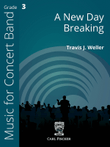Concert band Bass Clarinet, Bass Drum, Bassoon, Bb Euphonium, Bongos, Clarinet in Bb 1, Clarinet in Bb 2, Clarinet in Bb 3, Doumbek, Euphonium, Finger Cymbals, Flute 1, Flute 2, Gong, Horn 1, Horn 2, Oboe, Percussion 1, Percussion 2, Percussion 3 and more. - Grade 3
SKU: CF.CPS261F
Composed by Patrick Glenn Harper. Sws. Cps. Full score. 32 pages. Duration 5:22. Carl Fischer Music #CPS261F. Published by Carl Fischer Music (CF.CPS261F).
ISBN 9781491161715. UPC: 680160920402. 9 x 12 inches.
Sahara is an exciting programmatic work for concert band that musically paints a picture of a fantastical desert crossing in three contrasting sections. The first section depicts a large caravan moving across the giant dunes. The second section describes a visit to a palace in a mystical oasis city. The third section brings the piece to an epic close as the caravan outruns a sandstorm to reach their final destination. Performance Notes You may use a set of congas in addition to or in lieu of the dumbek part to bring out that pitched drum sound. At m. 4, emphasize the accented quarter notes in the horns and euphonium. Measures 17-26, make sure that the sixteenth note marimba part is heard clearly. In measures 48-92, this entire middle section may be played in a rubato style at the director's discretion to achieve maximum musical expression. Be sure to emphasize the crescendo-decrescendo dynamics in this entire section. In measures 56-61, be sure that the syncopated flute and clarinet parts are heard clearly. and the flute and oboe are heard as well mm. 76-81. The descending eighth notes in the bass clarinet and tuba part should be brought out in mm. 76-81. Measures 109-112, make sure to bring out the trills in the Flute and oboe parts and sustain them all the way through the measure with a release immediately on beat 1 of the following measure. And finally, mm. 125-126, emphasize the F Horn and Alto Saxophone parts.
Sahara is an exciting programmatic work for concert band that musically paints a picture of a fantastical desert crossing in three contrasting sections. The first section depicts a large caravan moving across the giant dunes. The second section describes a visit to a palace in a mystical oasis city. The third section brings the piece to an epic close as the caravan outruns a sandstorm to reach their final destination.Performance NotesYou may use a set of congas in addition to or in lieu of the dumbek part to bring out that pitched drum sound. At m. 4, emphasize the accented quarter notes in the horns and euphonium. Measures 17-26, make sure that the sixteenth note marimba part is heard clearly. In measures 48-92, this entire middle section may be played in a rubato style at the director’s discretion to achieve maximum musical expression. Be sure to emphasize the crescendo-decrescendo dynamics in this entire section. In measures 56-61, be sure that the syncopated flute and clarinet parts are heard clearly. and the flute and oboe are heard as well mm. 76-81. The descending eighth notes in the bass clarinet and tuba part should be brought out in mm. 76-81.Measures 109-112, make sure to bring out the trills in the Flute and oboe parts and sustain them all the way through the measure with a release immediately on beat 1 of the following measure. And finally, mm. 125-126, emphasize the F Horn and Alto Saxophone parts.
Sahara is an exciting programmatic work for concert band that musically paints a picture of a fantastical desert crossing in three contrasting sections. The first section depicts a large caravan moving across the giant dunes. The second section describes a visit to a palace in a mystical oasis city. The third section brings the piece to an epic close as the caravan outruns a sandstorm to reach their final destination.Performance NotesYou may use a set of congas in addition to or in lieu of the dumbek part to bring out that pitched drum sound. At m. 4, emphasize the accented quarter notes in the horns and euphonium. Measures 17-26, make sure that the sixteenth note marimba part is heard clearly. Inxa0 measures 48-92, this entire middle section may be played in a rubato style at the director’s discretion to achieve maximum musical expression. Be sure to emphasize the crescendo-decrescendo dynamics in this entire section. In measures 56-61, be sure that the syncopated flute and clarinet parts are heard clearly. and the flute and oboe are heard as well mm. 76-81. The descending eighth notes in the bass clarinet and tuba part should be brought out in mm. 76-81.Measures 109-112, make sure to bring out the trills in the Flute and oboe parts and sustain them all the way through the measure with a release immediately on beat 1 of the following measure. And finally, mm. 125-126, emphasize the F Horn and Alto Saxophone parts.








































